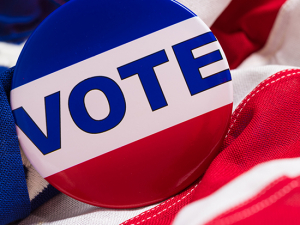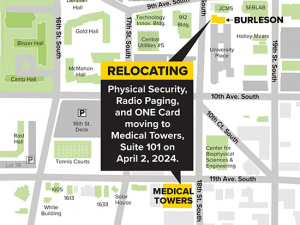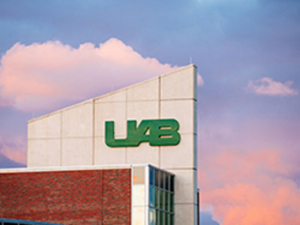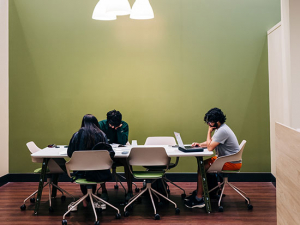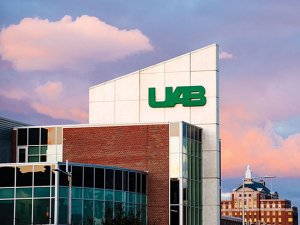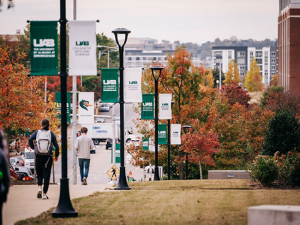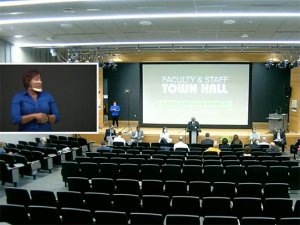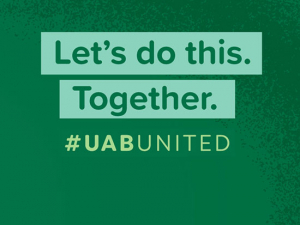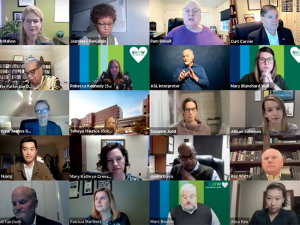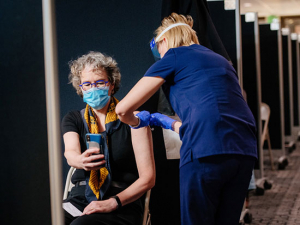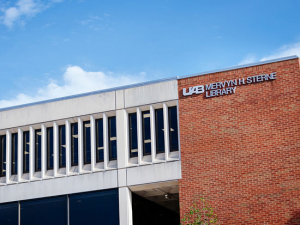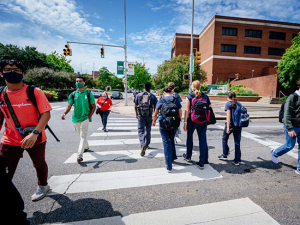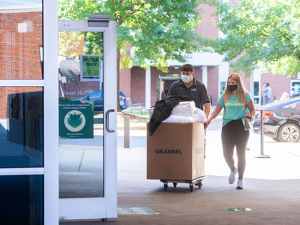Senior leaders shared more details around student schedules, teaching technology, COVID-19 exposures and other aspects of the return to campus for fall during a virtual town hall meeting Aug. 7.
“We have a very comprehensive plan for return to campus and it's the most rigorous of any university and academic medical center in the nation,” President Ray Watts said in his opening remarks. “We've already had our full clinical force on campus for months, and we've returned over 3,000 research personnel — that has gone very well over these last two months. We continue to increase on-campus presence for many of our support areas, and we have a plan to return to campus for start of classes Aug. 24.”
| This article summarizes the comments of UAB leaders and questions addressed during the town hall Aug. 7. A follow-up article will provide answers to all questions that could not be answered live due to time constraints. |
Watts and other speakers shared details of that plan, including the GuideSafe Entry Testing and other tools for health and safety monitoring throughout the semester, the release of student schedules the week of Aug. 10, and teaching technologies that will be used in hybrid instruction. Leaders also shared encouraging results from initial sentinel and entry testing showing a low prevalence of COVID-19 in the UAB community. “Data will drive all of our decisions, and you will hear a lot more data today from our speakers,” Watts said.
Scroll down to read the complete summary or use the links below to jump to specific topics
Incident Command Committee and Entry Implementation Committee
Hybrid learning, class schedules and syllabus language
Classroom technologies and hands-on training
Hospital admissions and initial data on COVID-19 prevalence on campus
Incident Command Committee and Entry Implementation Committee
Provost Pam Benoit began with a look at the “planning infrastructure that is going on behind the scenes” as faculty and employees prepare for the fall semester. Two committees have been working on many of these details, Benoit said.
The Incident Command Committee (see membership here) “oversees the safety of the return-to-campus processes and practices,” Benoit said. Their charge includes “examining data and interven[ing] when safe conditions are being breached.” UAB Chief Risk and Compliance Officer Katie Crenshaw chairs that committee.
The Entry Implementation Committee (see membership here), led by Graduate School Dean Lori McMahon, Ph.D., is “working through specific implementation and infrastructure issues to promote a smooth entry into campus,” Benoit said. The committee has been developing the class schedules that will be used in hybrid courses to notify students which days of the week they should attend in person and which days they should attend remotely. (More on this below.)
Question submitted online:
Has UAB established a tipping point in cases, either at the university or in the metro area in general, at which we will again go to remote-only instruction?
The plan for re-entry “includes multiple strategies for mitigating risk here on campus,” Crenshaw said. “And while we are monitoring our effectiveness in meeting all of those plan elements, there is not a single point, a tipping point, as it was called, in which those decisions will be made. We're looking at data in its totality and offering that to leadership to make the most data-driven, informed decisions about phases of return.”
Honoring Sergeant GuytonThe town hall began with a moment of silence in honor of UAB Police Sergeant Parnell Guyton, “a valued member of the UAB family who passed away last week after a very courageous fight after having developed COVID-19 in the spring,” President Ray Watts said in his opening remarks. UAB Police Chief Anthony Purcell noted that Guyton began his career at UAB in 1987 as an office services specialist in the Department of Medicine. He was hired as a UAB police officer in June 2004 and was promoted several times, reaching the rank of sergeant in 2013. “Not only was he an exemplary officer and supervisor, he was also beloved by the members of the UAB Police and Public Safety department and the community,” Purcell said. We will definitely miss Sergeant Guyton in the contributions he made to our department and the university.” |
“There are multiple data sets we're looking at, including modeling as well,” added School of Medicine Dean Selwyn Vickers, M.D. “Our head is not in the sand. We are really looking at those data points in a very rigorous way. And yet we're also mindful of the data that says that — at least in our community, that is at UAB — the numbers are not very high.” [More on early data on COVID-19 prevalence at UAB below.] At the same time, “we're not unaware of our community,” including the surge in cases in Alabama and specifically at UAB Hospital that had begun to level off as of the current week, Vickers said. “And that's why we pushed hard with our governor and others to get the mask order in place so that we can help slow this down and the hospital is not at a tipping point. [The hospital has] been stressed. But clearly, we are mindful of those numbers as well and appreciative that they're beginning to drop some.”
[back to topic list]
Hybrid learning, class schedules and syllabus language
McMahon then demonstrated the format of class schedules, which will be released to students and faculty starting Aug. 10. “I want to extend my thanks to all of you, for all of your hard work in planning your courses for the fall and all the creativity we have seen as you have moved your courses to a hybrid format,” McMahon said. “Our students will benefit greatly from all of your efforts.”
The scheduling of students into various cohorts for hybrid classes was accomplished by teams in Information Technology and the Banner system, McMahon said. For each enrolled class, students will see which of the four teaching categories it falls into — face-to-face, hybrid, remote or online — and, for hybrid courses, they will see a separate column listing the days they are scheduled to attend in person, and the days they are scheduled to attend remotely.
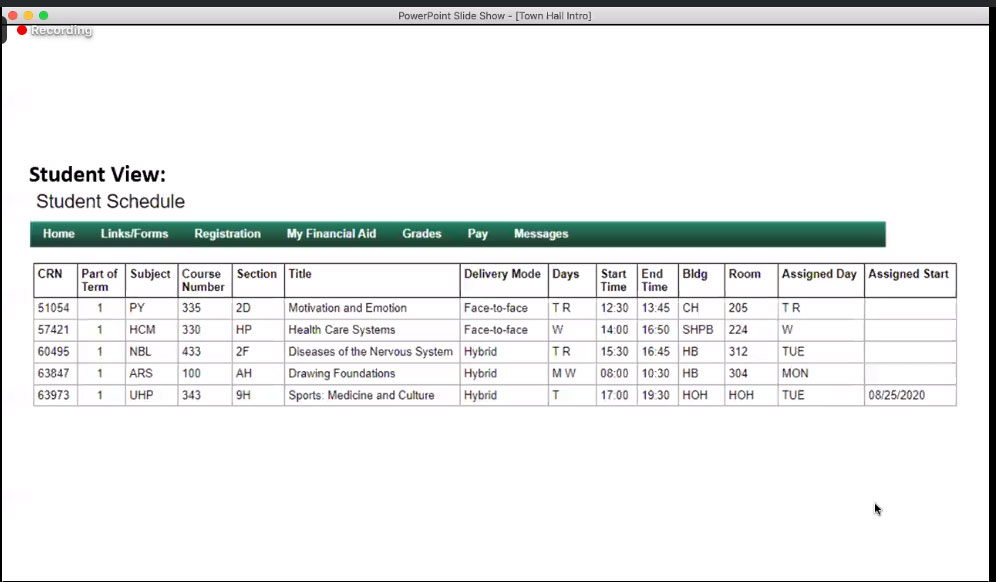 A sample student schedule, with the scheduled days for the student to attend classes in person in the Assigned Day column, second from right.
A sample student schedule, with the scheduled days for the student to attend classes in person in the Assigned Day column, second from right.
“As a faculty member, you don’t have to worry about making these assignments,” McMahon said. “The students will be able to see this all on their own.”
Faculty will be able to see, for each course they are teaching, a list of which students are designated to attend on each day. “You will see the students’ names enrolled in your course, and you will also see their assigned day to be in the classroom,” McMahon said. “A lot of that work has been done for you already.”
Questions submitted online:
Do faculty have the option to go 100% online instead of in-person?
“This is a conversation to have with your chair,” Benoit said. “We’ve already asked the chairs to work closely with their faculty to determine the right way of teaching a particular course.”
Courses for freshman and sophomores are being given priority for face-to-face and hybrid learning so that these younger students “can have that kind of experience when they first come to campus,” Benoit said. Honors courses and clinical courses are more likely to require the in-person or hybrid experience, she added.
“Hybrid is very flexible,” Benoit said. “It allows for a variety of different ways of teaching. If you attend one of those workshops that Scott Phillips was talking about earlier, you’ll see a variety of different ways in which you might think about that, including, for example, doing all the lectures online and then doing discussions in class.”
“I know that some instructors are using those in-person classes for further discussion or review sessions or problem sets,” McMahon said. “They don’t have to be lectures. If that’s the best way to deliver your content, it’s available. But if you want to use it in different ways, that’s a possibility as well.”
Must students come to campus on their day for hybrid learning or can they choose to stay away and participate from a remote location instead?
“The faculty set the attendance policy for their course,” McMahon said. “If you have an attendance policy where you require your students to be in person on their day that they are assigned, then the students should show up on that day. If your attendance policy does not require that then a student can choose to engage remotely if they wish.”
At a recent camp in Georgia, campers were sent home and it was singing and chatting that was attributed to the spread of COVID-19. So how would we advise handling discussions in the classroom in light of that?
“That [camp] was about the worst situation you could have put people in,” Watts said. “The counselors wore masks but all of the campers did not. They had a lot of close gatherings with singing and other activities. That was the perfect experience to show how virulent COVID-19 is, because about half of [the campers] got it. That’s the opposite of what we’re going to do. We will take every safeguard and make sure we avoid that. That is also why wearing a mask and physical distancing is required. There is zero tolerance for not doing that, mainly because you put all your colleagues and others around you at risk.”
“I will add that another feature you may have noticed recently in doing your Healthcheck is that we now have the Passport,” Benoit said. “When you’ve done your Healthcheck, it gives you a clear for that particular day. You get a green symbol that indicates that you are now clear for a 24-hour period. We are working through the logistics of that. But this could be very useful for faculty to know that students who are coming in to their class have not reported symptoms of COVID-19.”
What are the procedures if a faculty member teaching a hybrid class has contact with individuals who have tested positive for COVID-19, but all individuals are wearing face coverings?
“Anyone who is a non-health care provider who has a close contact exposure will be quarantined to home for 14 days,” Nafziger said. (Recall that a close contact exposure means spending more than 15 minutes closer than six feet to someone diagnosed with COVID-19, a situation that should not occur in the classroom with UAB guidelines.)
If such a situation did occur, “that’s why hybrid has so much flexibility,” Benoit said. “You can move that class into a different kind of format.”
Must teachers wear a mask while lecturing or are face shields without a mask ok?
“Yes, face shields [alone] are okay,” McMahon said. “I would just remind you to maintain that six feet social distancing. Instructors of record will receive two cloth masks and two shields. And so an instructor can decide on their own whether they prefer the shield or the mask. Just again to remind you, the six feet social distancing is really important to keep you safe and also your students.”
| This information is accurate as of publication. For the latest information on testing procedures and protocols, visit the uab.edu/uabunited site. |
“There was a question in the chat about, Are face shields really safe?” Benoit said. “We spent some time talking with our health care experts” on just this question and they “came back and said, as long as you're maintaining the six-foot distance, face shields should be sufficient. Of course, this is your choice. You could wear both, you could wear one or the other. It's up to you what you want to wear.”
[back to topic list]
Syllabus
The Entry Implementation Committee has developed language for faculty to include as part of the syllabus for their courses that includes “information for students about mask wearing, social distancing and some expectations… when they are in the classroom,” McMahon said. This document, which was reviewed by a number of campus stakeholders, including the Faculty Senate, is now available in Canvas.
[back to topic list]
Eating in class
One addition, finalized in the past few days, concerns eating lunch in classrooms. “Students will not be allowed to eat during their lectures in the classroom,” McMahon said. “They can have a bottle of water and they can remove their mask temporarily to take a drink, and the same for the faculty…. But eating has to be [done] outside the classroom.”
There are many lovely outdoor spaces for eating, McMahon said. “Other places for students to go include Bartow Arena. We’re getting that equipped with WiFi… and there will be spaces designated with tape on the floor and chairs” for students to eat and study. The School of Education, which will not be used for classroom space this fall, will be another designated area, along with the Hill Student Center, McMahon said.
In order to track the number of students in each area, “we plan to have a system in place where we will be able to use the One Tap system” so that students can tap their ONE Cards to register their presence.
[back to topic list]
Classroom technologies and hands-on training
Scott Phillips, Ph.D., director of the Center for Teaching and Learning, demonstrated some of the new technology that is being installed in classrooms across UAB. Phillips, speaking from the new CTL space on the fourth floor of Lister Hill Library, demonstrated a motion-tracking camera that can automatically follow instructors as they move across the front of the classroom. The camera can also be set to focus on a classroom whiteboard with the tap of a button so that students watching remotely can have a clear view of what is written.
Microphones will allow viewers to hear the faculty member as well as students participating in class discussions, and students attending remotely who join in the discussion will be heard by their classmates as well as the instructor, Phillips said.
The Center for Teaching and Learning has been presenting workshops throughout the summer, which have been attended by more than 600 faculty, Phillips said. Those will continue in August, with a full list of upcoming events and recorded workshops on the CTL site.
Faculty who want to “participate and experience this technology in person before classes begin” can register now for one of a series of trainings on the fourth floor of Lister Hill Library. These will be held on Aug. 18, 20, 24 and 26. “When you register, you will receive an email giving you information on how to safely enter the building,” Phillips said. “Five faculty can participate every half-hour, and we have schedules throughout the day.”
Virtual versions of classroom technology trainings are being presented by the Division of eLearning and Professional Studies, starting 5:30 p.m. Aug. 17.
To find out which technology is in your classroom(s), visit this searchable list on the eLearning site.
[back to topic list]
Hospital admissions and initial data on COVID-19 prevalence on campus
“We have had a significant number of COVID-19 admissions [at UAB Hospital] that have gradually and finally begun to come down,” noted Senior Vice President and School of Medicine Dean Selwyn Vickers, M.D. From a high of 138 hospitalized patients with COVID-19, “now we’re down below 100,” Vickers said.
UAB’s re-entry plan does not rest on any one component but on five core elements, Vickers said:
1. Robust education and training. “Some may feel this to be burdensome, but it’s critically important” to make sure everyone understands the behaviors necessary to prevent the spread of COVID-19, Vickers said.
2. Safety practices, including masks, distancing and reducing density in classrooms and other spaces.
3. Regular COVID-19 screening. The UAB Healthcheck, one part of the GuideSafe program, is a “powerful tool” that ideally should be used on a daily basis, Vickers said. That data is part of the metrics “being accumulated and followed through our Incident Command Center,” Vickers said.
4. Exposure notification app. This app, another element of GuideSafe, is a great backstop for fallable memory, Vickers noted. Anyone involved in contact tracing knows that when a newly diagnosed patient is asked to identify the people they have been in contact with in the past 14 days, they can’t recall that information half the time, Vickers said. And in many cases they don’t know the people who were around them, anyway.
The GuideSafe exposure notification app removes that problem by notifying people who have been in extended contact with an individual diagnosed with COVID-19 of the day when that exposure occurred. “It can be powerful, allowing people to know if they have had a significant exposure longer than 15 minutes and closer than six feet so they can react in an appropriate way,” Vickers said.
5. Entry testing. GuideSafe Entry Testing is a unique opportunity made possible “by the expertise and the expansion of our pathology labs and the support of the state” through nearly $30 million in CARES Act funding, Vickers said. And soon this expanded capacity will be transitioned for use in “testing hotspots in our community” as well, he said.
[back to topic list]
Prevalence at UAB
Vickers also shared data on prevalence of COVID-19 in student entry testing, begun in early August, and the randomized sentinel testing of staff, faculty and students already on campus, which began in July.
Of the nearly 10,000 entry testing tests completed, 1.2% have been positive, Vickers said, and the percentage of positive sentinel tests is at or less than 1%. UAB Hospital also has been testing non-COVID patients hospitalized for other conditions or for surgeries and has found a positive rate of about 0.7%. That evidence points to “the prevalence of the virus in our community — that is, the UAB campus — remains low,” Vickers said.
“In our testing of our populations that are asymptomatic, we do have a very low prevalence of disease,” said Sarah Nafziger, M.D., medical director for Employee Health. “That’s very encouraging for us.”
New quarantine guidance
During the past few weeks, the Alabama Department of Public Health and the Jefferson County Department of Health have updated their guidelines on isolation and quarantine of COVID-19-positive individuals and those with possible exposures.
Health care providers vs. non-health care providers
Whereas the health departments previously had separate guidance for “essential” versus “non-essential” workers, “now what we have is health care providers and everyone else” for isolation and quarantine, Nafziger said.
Essentially, all UAB Medicine employees are considered to be health care providers, even if they are not bedside providers, Nafziger said. “The services they provide are critical to use being able to provide those bedside services.” In addition, employees in Dentistry, Optometry, the Callahan Eye Foundation and some smaller groups are included in the health care provider category, Nafziger said. This group will see some increased focus on work restrictions and testing for people who live with a person who is COVID-19-positive, she said.
Non-health care providers will see more substantive changes, Nafziger said.
- Those who have symptoms of COVID-19 but return a negative test — and the symptoms resolve — will be allowed to return to work.
- Those who have had a close contact exposure to someone who is diagnosed with COVID-19, regardless of whether or not they were wearing a mask at the time, will be required to quarantine for 14 days.
“A close contact exposure, by health department definition, is if you are within six feet of a person who has COVID-19 for longer than 15 minutes…. From two days before the COVID-positive person’s symptoms developed until 10 days after their symptoms developed,” Nafziger said. “For non-health care providers, there’s no consideration about whether or not you had a mask on or a face shield or anything of that nature.” (For health care providers, the level of personal protective equipment worn is taken into account.)
Seating and other precautions in UAB’s classrooms have specifically been designed to separate all individuals by more than six feet. If someone in a class tests positive, “the whole classroom would not qualify as exposed,” Vickers said.
Who will be tested?
Any employee who meets one of the following two qualifications will always be referred for testing, Nafziger said:
- If you report even one symptom of COVID-19 on your Healthcheck
- If you live with someone who has been diagnosed with COVID-19
“All of those people are automatically going to be referred for testing and you report that using the Healthcheck.”
Employee Health additional staffing
In the past few weeks, Employee Health has added three more physicians from UAB’s Division of Infectious Diseases who are contacting employees with positive COVID-19 tests, answering their questions and managing care.
Employee Health also has added several contact tracers and employees in its call center.
Question submitted online:
Would an employee who was diagnosed with COVID-19 be required to test again after the end of symptoms and before they return to work?
“No, we do not require a negative test before returning to normal activities,” Nafziger said. “Previously, the CDC had recommended a test-based strategy for returning people to normal activities, but since that time they've kind of pivoted away from that,” Nafziger said. “What we found is people will continue to test positive for an extended period of time, even after they're no longer infectious or no longer contagious. The current recommendation is that we use a time- and symptom-based strategy, which is the preferred methodology. We've actually been using that for employees in Employee Health for several months now… and we found that to be a safe methodology.”
The medical logic behind this is that “when they culture the virus from people that test positive for a prolonged period of time, it's not viable virus,” Nafziger said. “It's kind of dead virus, if you will, that can't transmit disease.”
[back to topic list]
Research update
Christopher Brown, Ph.D., vice president for Research, shared that UAB’s research operation is “back on track” following the resumption of operations that began in late May. More than 600 research operation plans, explicitly detailing how each principal investigator will maintain social distancing and other safety measures, have been developed and approved by the relevant department chair, dean and Research Administration, Brown said. Those plans cover more than 3,000 employees and represent “about two-thirds of what we would consider our pre-pandemic level,” he added.
“As we continue to move forward and we learn things, the operational plans can and should be updated,” Brown said. “As you learn things about how you work in your own laboratory, get your plan back out, update it and then get it reapproved. It should be a very quick process.”
Any researchers who can do their work remotely — “and it is very possible and functional to work remotely,” Brown said — should continue to do so, he noted. “You don’t have to come in.”
UAB’s research performance continues to impress. In terms of external funding, “we’re up 7% relative to the same time last year, which is fantastic,” Brown said. “We’re also up significantly in the number of proposal submissions that have gone in. Our faculty and administrators are working hard to get those out to the funding agencies.”
UAB’s animal resources program is running at about 85% of pre-pandemic levels and the Southeastern Biocontainment Laboratory, “where a lot of work is done on infectious diseases such as SARS-CoV-2,” is “busier than it’s ever been,” Brown said.
With the support of philanthropic partners, UAB has been able to invest in 24 internal projects related to COVID-19 with high potential impact, Brown said. The early work that led to the UAB Healthcheck tool was funded this way, just as one example.
“We also are leaders nationally and internationally… in several clinical trials,” including the treatments remdesivir and convalescent plasma therapy, along with a number of vaccine trials, Brown said.
[back to topic list]
Caregiving
On July 24, all UAB and UAB Medicine faculty and staff received a link to a childcare and school survey designed to collection data to better understand the scale and scope of the issue.
“In the survey, we found that the majority of employees have children in either Jefferson County Schools, Hoover City Schools or Birmingham City Schools,” Watts said. “We know that Birmingham City Schools and Jefferson County Schools are going to be all-virtual to begin with, and Hoover has a mixed plan.”
With these results in hand, a task force led by Emily Wykle in the Office of the President has “been working very hard on finding options for our employees,” Watts said. “We are just pulling those recommendations together and they will be shared with everyone early to mid-next week [the week of Aug. 10]. We will have plans to help those who have no alternatives and then we’ll have a gradated plan to help others.”
Leaders have also encouraged supervisors to offer flexibility in schedules. “If someone has to teach a class on Tuesday and Thursday from 2 p.m. to 4 p.m., they need a mechanism to make sure they have child care during that time,” Watts said. “And we’re working toward that.” UAB Medicine is also putting together a plan for employees with child care needs, Watts said. “We know how important that is,” he said. “And we want to have the university and Health System be as proactive on your behalf as possible.”
[back to topic list]
Other questions
These questions were submitted online:
If we're shut down by government again, will there be more furloughs? How do you decide who gets furloughed? Are deans and/or chairs or supervisors involved in the decision-making?
“Right now we're not anticipating any negative financial impact for fiscal year 2021 beyond the budget scenarios that we've already put out,” said Allen Bolton, senior vice president for Finance and Administration. “If we do have another shutdown, all options will be back on the table and there is a very good review process that involves the leadership of the institution as well as the leadership of the Faculty Senate and of the Staff Council that would participate in those discussions.”
With the previous furlough, “we had those who are working on site, working remotely and those who are unable to work at all,” Chief Human Resources Officer Alesia Jones said. “Those that were unable to work at all” while UAB was in its limited business model “created our pool of employees that were furloughed, with some additional input from leaders,” Jones said.
Recent research shows that airborne transmission is a significant factor in spreading the virus. What is being done to address the issue of recirculated air and airborne transmission of the virus in classrooms, many which do not have windows?
The first item to consider is that everyone will be required to wear masks, said Chief Facilities Officer Greg Parsons. “Think of your mask as your personal air filter,” he said. “You're reducing the quantity of matter that's in the air.”
Another issue is the distancing measures that have been instituted in all UAB classrooms, Parsons said. “Classrooms were designed for certain amounts of air per person. And by cutting the occupant load you have in essence increased the amount of fresh air per person.
“None of our buildings are without fresh air,” he said. “Some of our laboratory buildings are 100% outside air — so therefore, there's no recirculated internal air. The vast majority of our buildings have 10 to 20% fresh or outside air. We're using the highest filter media possible and as an example, if we look at a typical 1,000-square-foot classroom that ordinarily would hold 40 to 50 people, [there will now be] 20 to 30 people in that classroom. In addition to that, the building, the air supply system delivers approximately 60,000 cubic feet per hour to that classroom space. That's a lot of air — a lot of dilution and a lot of fresh air. So we feel like we've got the systems in place. We've checked our filtration, we've checked the outside air, we've checked our exhaust. So we feel comfortable that we're providing the best air that our systems can deliver to the various classrooms.”
Will employees be tested?
Every individual on campus will be given an opportunity to be tested through the sentinel testing, Vickers said. “The unfortunate thing is that we’ve not had the full complement of people accept that opportunity. Our goal is to test somewhere between 2.5 to 3% — we solicit 4 to 5% of our population and… we get less than 2% participating. So I really would encourage all of us, if you get that email to participate in the testing, please do sign up. It’s not the nasopharyngeal swab. It’s just the anterior nasal swab. So you self-administer it and it’s not terribly difficult.”
An email sent Aug. 7 explained the optional COVID-19 testing for employees who are returning to campus, Jones added. “We recognize that some people will continue to work remotely for longer. If you have not been assigned a time to return to campus, we ask that you not participate in this optional testing at this time.”
[back to topic list]
“We know that this is a bit of a topsy-turvy beginning to the semester because things are ambiguous,” Benoit said. “But I know that everybody is trying so hard to make sure that we provide a quality educational experience to our students and we thank you so much for your efforts to do that and to be part of this team that makes sure that we are one of the safest campuses in the country.”
Watts echoed that sentiment. “I want to thank everyone for all of your contributions,” he said. “I hope that you can hear from the comprehensive and rigorous nature of every aspect that we have considered, and we continue to consider, that we intend to keep our UAB community very safe. We encourage everyone to help one another make sure we follow these basic safety guidelines.”

